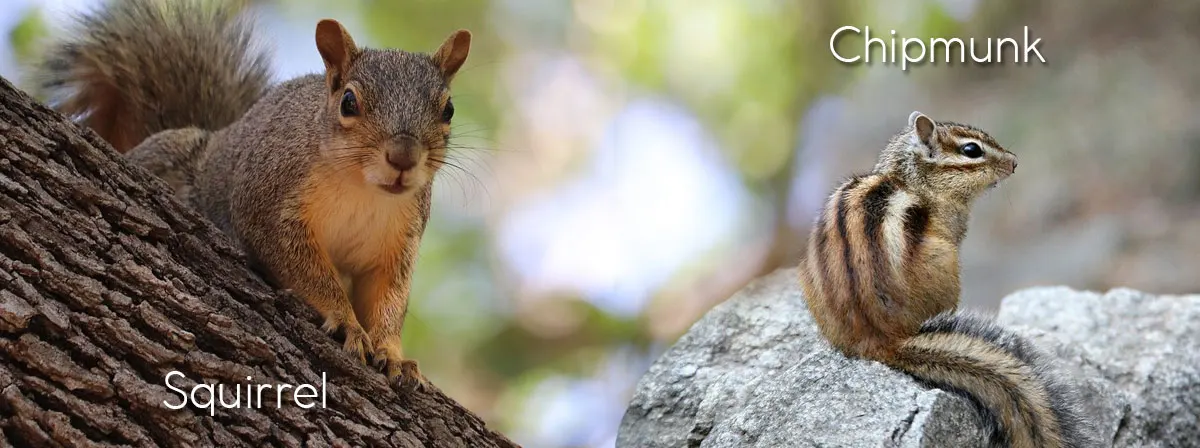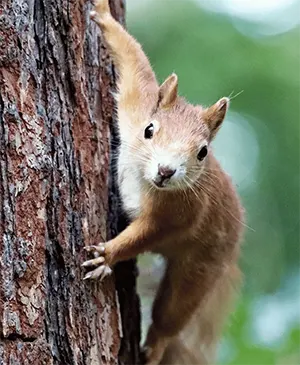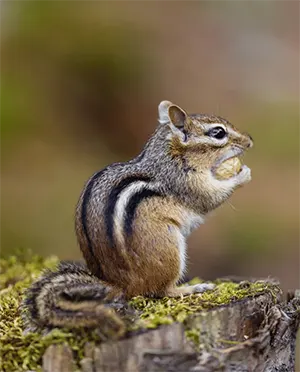Have you ever wondered about those furry (and quite charming) little critters scurrying about in your yard? How do you know whether you are looking at a chipmunk or a squirrel?
Chipmunk vs. Squirrel
When we talk about chipmunks vs. squirrels, we'll find that they have an awful lot in common... and a few key differences. Both are members of the Sciuridae family (and so are over 250 other little rodents!) and both are found in nearly all parts of Canada. Their diets are very similar, as are their enemies. With that said, let's look at what distinguishes one from the other.
Physical Characteristics
Size and Body Shape
 Squirrels (and here in Ontario, that generally means the Estern Grey Squirrel) are considerably larger than chipmunks and measure about 10-12 inches plus a tail nearly the same lenth. A squirrel's back legs are longer than the front and make them excellent jumpers. Chipmunks, on the other hand rarely measure more than 7.5 inches with a short and somewhat stubby legs and considerable shorter and thinner tails.
Squirrels (and here in Ontario, that generally means the Estern Grey Squirrel) are considerably larger than chipmunks and measure about 10-12 inches plus a tail nearly the same lenth. A squirrel's back legs are longer than the front and make them excellent jumpers. Chipmunks, on the other hand rarely measure more than 7.5 inches with a short and somewhat stubby legs and considerable shorter and thinner tails.
Fur Color and Patterns
The Eastern Grey Squirrel comes in 50 shades of grey :) Well, brown-ish to grey-ish. Actually, most are very dark and there seems to be a connection between a colder climate and darker fur. The red squirrel, of course, will have more of a reddish-brown coloured fur. No matter the squirrel, its fur will be uniform and one colour or shade. Chipmunks however, have a rather intricite and pretty stiped head and body: five dark and four light stripes along their sides and three dark and two light stripes on their face. Their fur is orange-brown and their belly is light coloured.
Facial Features
The smaller chipmunk has delicate features with those distinctive stripes, big black eyes and a pointy nose, covered in whiskers. They also sport cheek pouches with an impressive capacity to store and transport food and small upright rounded ears. In contrast, squirrels have even coloured faces, a little more rounded nose, more prominent whiskers, and proportionally larger ears. They also have some storage space in their cheeks, but to a much lesser degree.
Habitat and Distribution
Preferred Environments
Squirrel:
The Eastern Grey Squirrels is found in a range of habitats from all types of forests to urban backyards. Thanks to our love for feeding birds, squirrels quite happily live alongside humans. While much time is spent in trees, food gathering is mostly done on the ground.
Chipmunk:
Chipmunks spend much of their lives underground. They burrow into the ground, ideally beneath ample brush or ground cover. Howerver, they are excellent tree climbers and swimmers and, like squirrels, do their foraging above ground.
Geographical Range
Squirrel:
Squirrels are indigenous to the Americas, Eurasia, and Africa, but have been introduced in Australia as well now. In Canada, the Eastern Grey Squirrel is found in Ontario, Manitoba, Saskatoon, and British Columbia.
Chipmunk:
Chipmunks are found in moderate climates. In Canada, they are present in all provinces, except the northern regions and the Rocky Mountains.
Nesting Habits
Squirrel:
Squirrel nests are called “dreys.” Squirrels will build intricate structures up high on tree branches, ofen into a fork of 2 or more branches. They may also find and occupy hollow spaces in tree trunks, often abandoned dwellings of other animals or birds. Both male and female squirrels build nests or dreys and often have a second “back-up” nest to enable a quick escape if pursued by predators.
Chipmunk:
Much like their squirrel cousins, chipmunks build themselves some pretty elaborate dens - just underground. A chipmunk's den can be anywhere from 17-30 inches deep with the main nest chamber at the end of a tunnel, furnished with insulating materials such as grasses, leaves, and other materials.
 Behavior and Lifestyle
Behavior and Lifestyle
Social Structure
When exploring squirrels vs. chipmunks differences, we actually find that they have quite a bit in common. Both are solitary creatures for the majority of their lives. Both males and females occupy separate dens or dreys. Territories may overlap and they may live in relatively close proximity to one another. Older, larger males are at the top of the hierarchy and dominate younger or female neighbours.,
Daily Activities
Again, we find more in common than not when it comes to their daily business. Both squirrel and chipmunk spend much of their days foraging and storing (hiding!) food. Their activities may be rescheduled to early morning hours or later in the day in the summer heat.
Hibernation Patterns
Now, here's another similarity. Squirrels and Chipmunks do not truly hibernate but enter a state of torpor, slowing down their body temperature, breathing, heart rate, and metabolism to conserve energy in the thick of winter. They will stay in this state for a few days at a time, waking up every 5-8 days to raise their body temperature and to feed.
Diet and Feeding Habits
Food Preferences
Both squirrels and chipmunks are omnivores - meaning they CAN eat meat, vegetables, fruit, and other plants. Favourites, by far are shelled nuts, acorns, strawberries, and of course, all sorts of seeds. This may be apparent by the speed with which your bird feeder requires restocking.
Foraging Techniques
Ah, now here we find
Food Storage Methods
Ah, now here we find some differences between chipmunks and squirrels. Chipmunks are considered "central placed foragers" - meaning they will bring their treasures back to one central location, most often their burrow. Depending on the travel distance needed to gather food, chipmunks may create a smaller, shallow burrow strictly for storage. Squirrels, on the other hand, are "scatter hoarders" - meaning they'll 'hide' food here and there, and over there, too. The more desirable the food, the more secretive the location.
Reproduction and Life Cycle
Mating Seasons
Both can mate twice in one year. Squirrels will mate somewhere from mid-December to early January and possibly again in June. Chipmunks will mate from February to April, and again from June to August.
Gestation and Litter Size
Squirrels:
After a 42-45 day gestation period, a female will give birth to 2-4 kits (sometimes called pups), sometimes more.
Chipmunks:
After a 31 day gestation period, momma chipmnunks will give birth to 2-8 babies on average.
Lifespan in the Wild
A healthy squirrel with plenty of access to food can live up to 12 years in the wild. Sadly, a chipmunk's life expectency is just half of that - 6 years.
Beyond Chipmunks vs. Squirrels: Learn More About Wildlife with Hawkeye!
It's wonderful to observe all that nature has to offer and squirrels and chipmunks can be quite entertaining to watch. But both can cause a fair bit of destruction and damage around your home. If you need help evicting a squirrel from your attic, or a chipmunk from burrowing through your yard, contact Hawkeye Bird & Animal Control. We're here to help with Chipmunk or Squirrel Removal!














